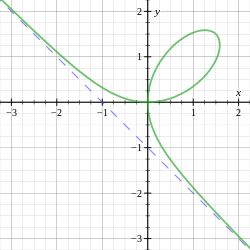Genus–degree formula
In classical algebraic geometry, the genus–degree formula relates the degree d of an irreducible plane curve with its arithmetic genus g via the formula:
Here "plane curve" means that is a closed curve in the projective plane . If the curve is non-singular the geometric genus and the arithmetic genus are equal, but if the curve is singular, with only ordinary singularities, the geometric genus is smaller. More precisely, an ordinary singularity of multiplicity r decreases the genus by .[1]
Proof
The proof follows immediately from the adjunction formula. For a classical proof see the book of Arbarello, Cornalba, Griffiths and Harris.
Generalization
For a non-singular hypersurface of degree d in the projective space of arithmetic genus g the formula becomes:
where is the binomial coefficient.
Notes
- ↑ Semple, John Greenlees; Roth, Leonard. Introduction to Algebraic Geometry (1985 ed.). Oxford University Press. pp. 53–54. ISBN 0-19-853363-2. MR 0814690.
See also
References
- This article incorporates material from the Citizendium article "Genus degree formula", which is licensed under the Creative Commons Attribution-ShareAlike 3.0 Unported License but not under the GFDL.
- Enrico Arbarello, Maurizio Cornalba, Phillip Griffiths, Joe Harris. Geometry of algebraic curves. vol 1 Springer, ISBN 0-387-90997-4, appendix A.
- Phillip Griffiths and Joe Harris, Principles of algebraic geometry, Wiley, ISBN 0-471-05059-8, chapter 2, section 1.
- Robin Hartshorne (1977): Algebraic geometry, Springer, ISBN 0-387-90244-9.
- Kulikov, Viktor S. (2001) [1994], "Genus of a curve", in Hazewinkel, Michiel, Encyclopedia of Mathematics, Springer Science+Business Media B.V. / Kluwer Academic Publishers, ISBN 978-1-55608-010-4
